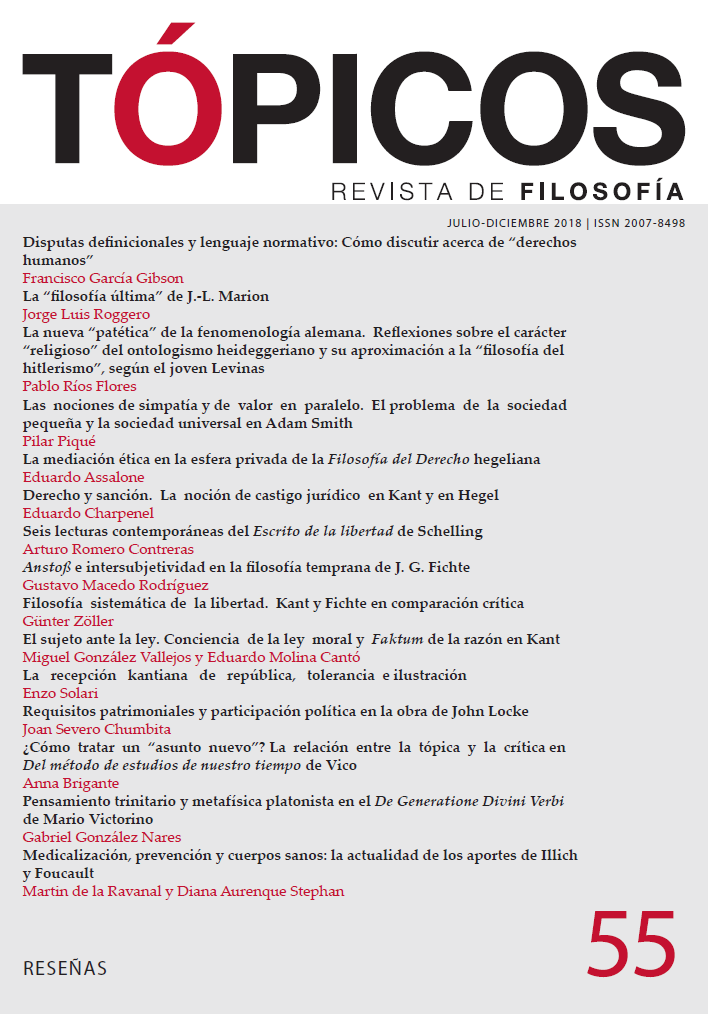Published 2018-06-08
Keywords
- Schelling,
- Karatani,
- Merleau-Ponty,
- chiasm,
- par- allax
- non-classical logic,
- topology. ...More
How to Cite
Abstract
The following paper offers six contemporary readings of Schelling ́s Freedom essay. It begins by explaining the funda- mental problem of the Essay, namely the contraction between freedom and necessity and between ground and existence. The principle of ground must be understood in ontological sense, and implies a hierarchic and necessary relationship between the elements involved. The principle of existence is rather of ethical nature and implies a separation, non-necessary and horizontal relationship of its members. Hence the question: how to think the “simultaneity” of two irreconcilable fundamental positions? To address this issue I offer a confrontation between Adorno and Schelling regarding non-identity thought. Finally I offer six contemporary readings of the Essay, which can be sorted in two groups: a) a logical-topological perspective (involving non-clas- sical logics and topology) and b) a reading from four contem- porary thinkers: Karatani, Blondel, Merleau-Ponty and Günther and three closely-related notions developed by them: that of parallax, chiasm and diplopy.
References
- Blondel, M. (1934). La Pensée. Vol. II. Les responsabilités de la pensée et la possibilité de son achèvement. Paris : Félix Alcan.
- Brunel, H. (2004). La felicidad Zen. Los más bellos cuentos Zen. Tr. Jerónimo Sahagún, Barcelona: El barquero.
- Chesterton, G.K. (2014). G.K. Chesterton: The Dover Reader. Mineola, Nueva York: Dover Thrift Editions.
- Derrida, J. (1972). Marges de la Philosophie. París: Les Editions de Minuit.
- Günther, G. (1953). The Logical Parallax. Astounding Science Fiction, LII (3), 123-133.
- Günther, G. (1980). Beiträge zur Grundlegung einer operationsfähigen Dialektik: Vol. III Band: Philosophie der Geschichte und der Technik. Wille, Schöpfung, Arbeit. Hamburgo: Meiner.
- Janke, W. (2008). Die Dreifache Vollendung des deutschen Idealismus: Schelling, Hegel und Fichtes ungeschribene Lehre. Fichte-Studien, Supplemementa (Band 22). Ámsterdan y Nueva York: Rodopi.),
- Kant, I. (1989), Sueños de un visionario, explicado por los ensueños de la metafísica. Edición crítica dcl texto alemán, introducción, traducción y notas de Cinta Canterla. Cádiz: Universidad de Cádiz.
- Karatani, K. (2003), Transcritique. On Kant and Marx. Trad. Sabu Kohso. Cambridge, Massachusetts y Londres, Inglaterra: The MIT Press.
- Lafont, C. (1993). La razón como lenguaje. Madrid: Visor.
- Leyte, A. (1998). Las épocas de Schelling, Madrid: Akal.
- Merleau-Ponty, M. (1964). Le visible et l'Invisible. Suivi de notes de travail. Texto establecido por Claude Lefort. París: Gallimard.
- Merleau-Ponty, M. (1995). La nature: Cours du Collège de France, notes. París: Éditions du Seuil.
- Nikhilananda, S. y Mukerji, D.G. (2011), Sri Ramakrishna. The face of silence, Ed. by Swami Adiswaranda. Mumbai: Jaico Publishing House
- Priest, G. (1995). Beyond the limits of thought. Cambridge: Cambridge University Press
- Rosenzweig, F. (1997). La Estrella de la Redención. Ed y trad. Miguel García-Baró. Sígueme: Salamanca.
- Schelling, F.W.J. (1948). Die Weltalter. Ed. M. Schröter. Múnich: Biederstein.
- Schelling, F. W. J. (1989). Investigaciones filosóficas sobre la esencia de la libertad humana y los objetos con ella relacionados. Ed y trad. de Helena Cortés y Arturo Leyte. Barcelona: Anthropos y Madrid: Ministerio de Educación y Ciencia.
- Schelling, F.W.J. (1998). Schelling's sämmtliche Werke (Edición en CD-Rom). Ed. E. Hahn. Berlin: Total Verlag.
- Schelling, F. W. J. (2002). Las edades del mundo. Textos de 1811 a 1815. Ed. Jorge Navarro Pérez. Madrid: Akal.






